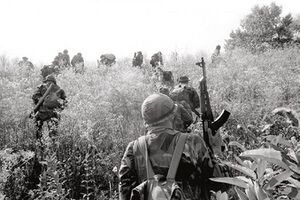Wardens (Syara)
| Wardens | |
|---|---|
| Ovlaštene | |
 Symbol of the Warden Way | |
| Leaders | Kazys Ulinskas Aris Jēkabsons |
| Dates of operation | 1986-1987 |
| Headquarters | Slocova |
| Active regions | Syara |
| Ideology | Syaran nationalism Zobethos Fundamentalism |
| Opponents | Royalists |
The Wardens were the followers of the Warden Way, a Syaran nationalist philosophy that was created by Syaran author and activist Serovpe Boyajian. Although Boyajian's original text was not overly militarized and focused heavily on ecology, his criticisms of the Monarchies of Galania and Makedon led to a sharp increase in their unpopularity throughout Syara. Followers of the Warden Way came to be known as the Wardens, who became a major national organization opposed to the continued power of the Monarchists. The Wardens would seize power in the Syaran Government during the 1970s and began upsurping the traditional powers of the monarchs in exchange for a more nationalist and Zobethos fundamentalist approach to government.
The Warden led High Council attempts to strip the Makedonian and Galanian royal families of their titles and power in December 1984 led to the Refusal War. The Wardens benefited from greater popularity among the Syaran people, and received international backing from states Cacerta, Tennai, Quenmin, and Æþurheim. The Wardens emerged victorious in the war and afterwards would reform Syara into a Commonality, led by the pro-Warden Union Party.
Origin
The Wardens emerged as followers of Serovpe Boyajians' work The Warden Way, which preached a neo-fundamentalist/conservationist approach to Syaran society that emphasized Syara's relationship with Zobethos, the national religion of the Republic. Although Boyajians' work was heavily focused on ecology and society, it contained noticeable and significant criticism of the dual-monarchies of the Baligov and Kinesean dynasties. Boyajians' claims resonated deeply with a Syaran populace that had grown disillusioned with Syara's traditional form of government in the aftermath of the Broken Years, along with the crippling of the aristocracy as a result of the Siduri War. The adherents of Boyajians' teachings, known as the Wardens, came to prominence in the 1960s and 1970s with their own distinct strain of populist-nationalism, intermixed with a strong current of Zobethos fundamentalism.
Despite Boyajian's death in 1970, the Wardens continued to rise in popularity, especially in Scitaria and Hayreniky, where Zobethos fundamentalism and Syaran anti-monarchist sentiment was high. Between 1972-1978 the Wardens saw widespread electoral victories across Syara's Realms and national offices, with the United Syara Party becoming the de facto political vehicle for the Warden ideology.
Philosophy
The Warden philosophy largely transcended the traditional left-right divide in Syaran politics, though it was common for analysts to subscribe Warden beliefs to right wing aspirations towards intermixing of nationalism and religions fundamentalism. The Wardens largely scorned Syaran conservatism, which was dominated by Royalist supporters while liberal elements of Syaran society, who proved more secular, were at odds with the Warden emphasis on the centrality of faith in Syaran society and politics. Despite the strong religious and national convictions the Wardens proved more flexible on economic matters, with writer Zlatko Lazarov noting "...on matters of money the Wardens drop much of their rhetoric in favor of earnings".
Organization
The Wardens never formed an official political party, but over time the United Syara Party came to emerge as the premier pro-Warden political force in the Senate and across the Realms. Upon the outbreak of the Refusal War the Wardens reformed in Slocova and senior political and military leadership loyal to the Warden cause. The Wardens continued to maintain that Robert Križan, who had been elected interim President on 12 November 1983, was the official national leader of Syara. With Zovahr in Royalist hands, along with many of the organs of government, the Wardens had difficulty surmounting the political capital of the Royalits, who had received backing from several foreign powers. Although the Wardens insisted throughout the war that Križan was the legal President of Syara, Saša Mlinarić quickly overshadowed Križan and came to be seen as the de facto leader of the Wardens. In 1986 he was named Supreme Commander of the Warden Armies, a role he had largely held since the beginning of the conflict.
During the war the Warden armies were divided into two main strategic groupings, collectively known as Army Group Scitaria and Army Group Hayreniky. Under the Army Groups were field armies named after geographic features, usually rivers that were within their area of opreations (Army of Danjusha, Army of Thanor). Armies were composed of corps, then divisions, then brigades, and finally battlegroups. To avoid confusion, Syaran histography typically employs a numbered convention Royalist forces, and the names of commanders for Warden formations (Kostović's Corps, Pashian's Division, Kasajian's Brigade, Dinev's Battlegroup).
The Wardens employed mass conscription within the territoriy they controlled to amass their armies, and were complemented by volunteers and defectors from Royalist territory. At their peak, the Wardens numbered 3.5 million men under arms. The core of the Warden forces were veterans of the Army of the Syaran Republic, many of whom were veterans of the Granika Border War and the Hayren War.
Weapons and tactics
The Wardens were armed heavily with weapons produced in the Republic of Syara, often times with military units of the Armed Forces of the Syaran Republic joining the Wardens with their entire arsenal. Additional weapons and equipment, including supplies of fuel, munitions, food, medicine, and spare parts were supplied by friendly nations. The Wardens also scavenged equipment and arms from Royalist forces that had been defeated or captured. The Wardens employed a wide variety of light arms, including assault rifles, machineguns, mortars, rocket launchers, MANPADS, and sniper rifles. The Wardens made extensive use of improvised rockets, explosive devices, and mines for both offensive and defensive operations. More than 450,000 Vitali SDM 1963s, and more than 50,000 Vitali MG50 HMGs were supplied by Cacerta.
The basic unit of the Wardens was the section, consisting of two teams of six men each, usually equipped with a rocket launcher and a machinegun. Despite a shortage of spare parts and equipment, the Wardens went to great length to maintain a degree of mechanization and motorization, often employing foreign mechanics and technicians to keep tracked armored fighting vehicles and operable. The most significant formation of the Warden armies was the battlegroup, a mixed combined arms force centered around a battalion of infantry, supported by armor, artillery (usually mortars), rocket launchers, and portable air defense systems. Battlegroups formed the center of the Wardens tactical capabilities, and were known for their flexibility and capability that often surpassed the tactical groupings employed by the Royalists. Despite being an army of largely light infantry, the Wardens made extensive use of maneuver warfare to defeat their opponents, employing elaborate flanking actions and movement drills.
To avoid enemy air power, the Wardens often made an effor to be in constant motion, with one element attacking rapidly before disengaging, while another moved to fire. To engage enemy hardpoints and centers of resistance, the Wardens extensively employed stealth and infiltration tactics, often moving only at night to avoid detection. Deception was a major component of the Warden military lexicon. Warden forces made extensive use of decoys and camoflauge to conceal troop positions and weapons emplacements. This was elaborate enough that at one point the Wardens succesfully hid a bridge over the Thanor River from enemy airpower by constructing a mockup 50 meters upstream while covering the real bridge with darkened tarps to make it appear to blend in with the nearby vegetation and confuse aerial reconnaissance.

Short of aircraft, the Wardens instead relied heavily on air defense systems and mobile surface-to-air missile launchers to deter enemy aircraft. Wary of anti-radiation missiles and dedicated SEAD operations, the Wardens opted to keep most of their radar systems offline during lulls in the fighting, and usually activated their systems only in short intervals to minimize detection. During major operations the Wardens made extensive use of offensive air defense measures to limit enemy air power, usually setting up mobile SAM launchers near easily concealable terrain. Two common tactics for negating enemy air power were to strip radar systems from decomissioned aircraft to distract radar-homing missiles, while using heat lamps, open flames, and heaters on abandoned vehicles to fool infrared sensors. Over the course of four years of fighting, the Wardens downed around 1,842 Royalist, Acrean, and Ossorian aircraft.
Kaitlyn Quintilian, commander of the 5th Guards Mechanized Army, commented on the Wardens in her memoirs:
The [Wardens] were a paradox of sorts. When lined up for formation they resembled little more than an armed gang, mismatched kit and weapons from all four corners of the world. Between the barking of NCOs and the jeering of officers they appeared a mixed rabble of hooligans, but these were the same troops who would fall in line and conduct silent marches through mountains, forests, snow, rain, and fog. The Warden had an almost draconian level of discipline within himself; deviances were mercilessly punished by superiors and liable to earn scorn from their peers. Consumption of alcohol was strictly limited and drunkeness was likely to earn onceself a forced march up and down hills and through valleys until it had been sweated out. They were a humorless lot who's only chants and cheers came in the form of prayers said before and after battle, who took to their struggle with a grim, fatalist determination.
They tolerated our presence more than anything, a memory of our historical relations. I stood once atop an Ariete after Durova, with a Warden commander by the name of Kostović and I asked what he had thought of our performance. He said nothing of my troops or tanks, but merely narrowed his eyes to say "We call you sib, but your mind and meaning are a mystery to us".
I told him our intentions were pure. I spoke of reasons for our support and repeated what I had been told before by my own superiors. He took them without comment. Undeterred, I asked if he could look past the animosity our nations once shared. He only shook his head "We cannot forget those whose cords you cut. Forgiveness is not ours to bestow. Your people have brought Syara grief and jubilation beyond measure."
He said this with neither pain nor glee, as if it were just a matter of undeniable fact. Perhaps it was true, but there I was nothing I could do about it except tend to my duties. I could only ask what he thought of our chance at victory, confident was I but aware of the forces arrayed before us. He shook his head again, as if recognizing my concern. "With you besides us, a talisman of victory, the day of freedom draws nigh. Let this war end in either total victory or our extinction. No further compromise shall we allow."